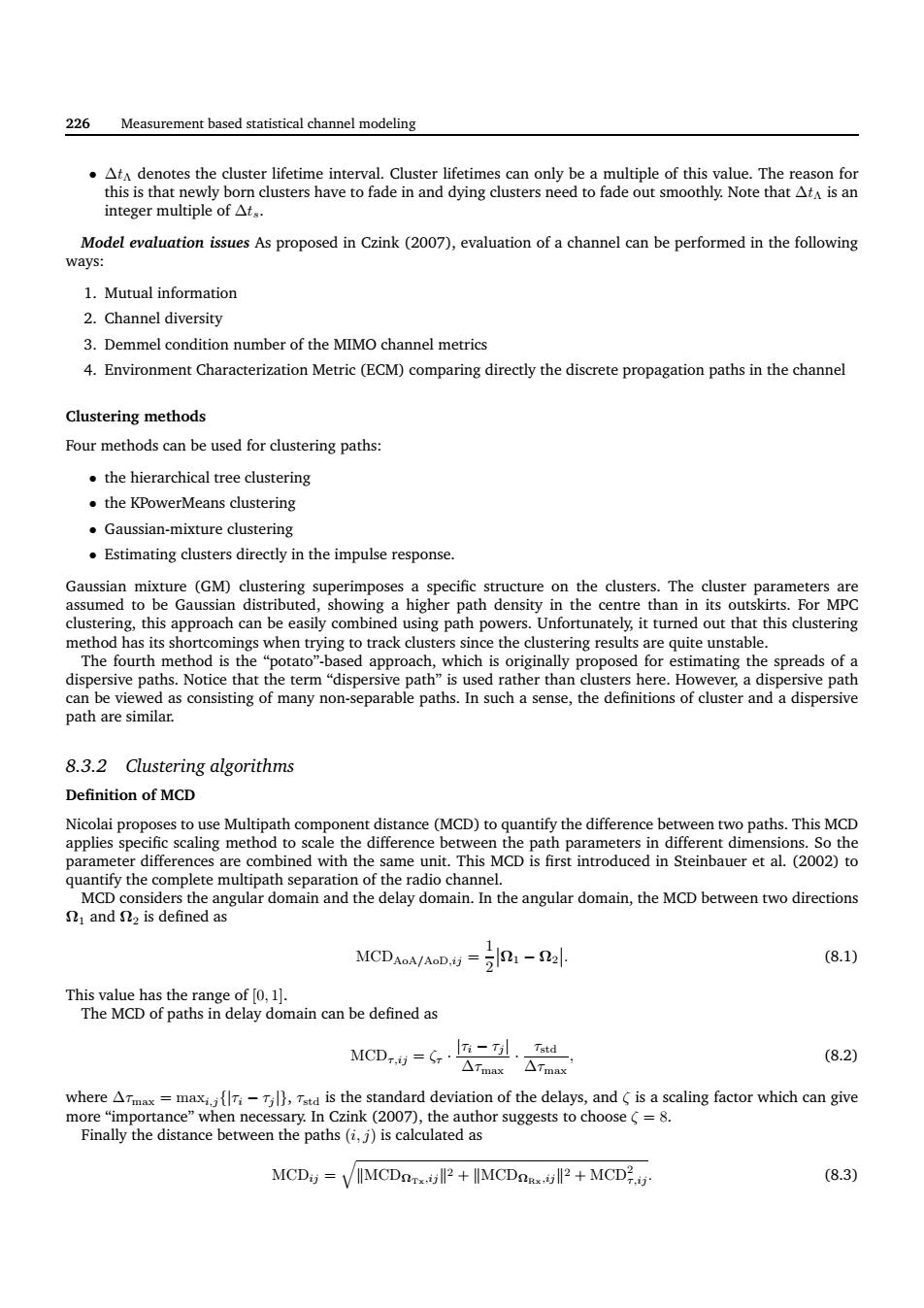正在加载图片...

226 Measurement based statistical channel modeling A integer multiple of At.. Model ses s proposed in Cink (7),valuation of chane the follwn wa 1.Mutual information 2.Channel diversity 3.Demmel condition number of the MIMO channel metrics 4.Environment Characterization Metric (ECM)comparing directly the discrete propagation paths in the channel Clustering methods Four methods can be used for clustering paths: .the hierarchical tree clustering the kPowerMeans clustering .Gaussian-mixture clustering .Estimating clusters directly in the impulse response. custerin this approach can be easily combined using path powers.Unfortunately it turned out that this clusterin method has its when trying to track uster the usering results are quite unstabl dispersive paths.Notice that the raher han clusters here. of many on-sprab paths n ch the dfnon of ceradipeiv Path 8.3.2 Clustering algorithms Definition of MCD Nicolai proposes to use Multipath component distance (MCD)to quantify the difference between two paths.This MCD c scaling metho to scal the differenc complete multipath separation of the radio channel. noenae器artonsnandtctytmsnnteagahrdaaeMobewemwiadinm MCDAOA/AOD.=-2l (8.1) MCD.=.I (8.2) the standard deviation of the delays,and is a scaling factor which can give r suggests to choose MCD VIMCD2+MCD2+MCD (8.3) 226 Measurement based statistical channel modeling • ∆tΛ denotes the cluster lifetime interval. Cluster lifetimes can only be a multiple of this value. The reason for this is that newly born clusters have to fade in and dying clusters need to fade out smoothly. Note that ∆tΛ is an integer multiple of ∆ts. Model evaluation issues As proposed in Czink (2007), evaluation of a channel can be performed in the following ways: 1. Mutual information 2. Channel diversity 3. Demmel condition number of the MIMO channel metrics 4. Environment Characterization Metric (ECM) comparing directly the discrete propagation paths in the channel Clustering methods Four methods can be used for clustering paths: • the hierarchical tree clustering • the KPowerMeans clustering • Gaussian-mixture clustering • Estimating clusters directly in the impulse response. Gaussian mixture (GM) clustering superimposes a specific structure on the clusters. The cluster parameters are assumed to be Gaussian distributed, showing a higher path density in the centre than in its outskirts. For MPC clustering, this approach can be easily combined using path powers. Unfortunately, it turned out that this clustering method has its shortcomings when trying to track clusters since the clustering results are quite unstable. The fourth method is the “potato”-based approach, which is originally proposed for estimating the spreads of a dispersive paths. Notice that the term “dispersive path” is used rather than clusters here. However, a dispersive path can be viewed as consisting of many non-separable paths. In such a sense, the definitions of cluster and a dispersive path are similar. 8.3.2 Clustering algorithms Definition of MCD Nicolai proposes to use Multipath component distance (MCD) to quantify the difference between two paths. This MCD applies specific scaling method to scale the difference between the path parameters in different dimensions. So the parameter differences are combined with the same unit. This MCD is first introduced in Steinbauer et al. (2002) to quantify the complete multipath separation of the radio channel. MCD considers the angular domain and the delay domain. In the angular domain, the MCD between two directions Ω1 and Ω2 is defined as MCDAoA/AoD,ij = 1 2
Ω1 − Ω2
. (8.1) This value has the range of [0, 1]. The MCD of paths in delay domain can be defined as MCDτ,ij = ζτ · |τi − τj | ∆τmax · τstd ∆τmax , (8.2) where ∆τmax = maxi,j{|τi − τj |}, τstd is the standard deviation of the delays, and ζ is a scaling factor which can give more “importance” when necessary. In Czink (2007), the author suggests to choose ζ = 8. Finally the distance between the paths (i, j) is calculated as MCDij = q kMCDΩTx,ijk 2 + kMCDΩRx,ijk 2 + MCD2 τ,ij . (8.3)